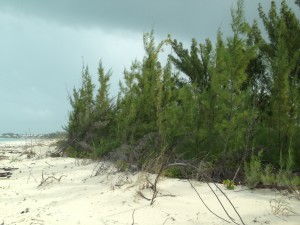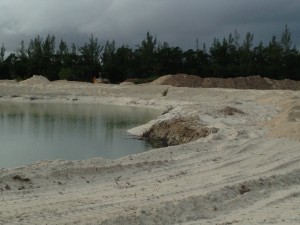Plovers in Paradise
The Bahamas Blog – Trip 1, Day 4
By Todd Pover, Beach Nesting Bird Project Manager and Stephanie Egger, Wildlife Biologist

Today was a reality check – a reminder that not every day of the project can be a highlight reel. There was work from other projects to catch up on. We had a public presentation in the evening on the importance of the Bahamas for piping plovers and we had to finish prepping for that. The van needed to be gassed up and the biologists need fuel too so a trip to the grocery store was in order. And finally, it was pouring rain all morning.
Luckily, the sun peaked out mid-day, so we headed to Treasure Cay, a popular planned community and resort north of Marsh Harbor. On the surface the long beautiful crescent beach provided perfectly suitable habitat for piping plovers. However, expectations were not particularly high for a sighting because there is not a well established history of plovers at the site. And as it turned out, no piping plovers were found today. But determining both where birds are and aren’t present is an equally important part of the scientific and conservation process.
The trip to Treasure Cay was also a reminder that as much as the Bahamas is a winter paradise for piping plovers it isn’t totally problem free either. In the grand scheme, Treasure Cay is a fairly modest development, not the type that would raise glaring red flags, but it is still a microcosm of the issues that warrant attention.

Compared to all the other sites visited so far on this trip, it was the most developed (right on the beach in some cases) and had the most human activity on the beach – is this what accounted for the lack of plovers on this beach or are other factors at work? Like many sites, the beach is lined with Casuarina, an non-native invasive tree that is altering the natural beach habitat, making it less suitable for shorebirds like piping plovers. Although not noted at Treasure Cay, dogs were observed roaming other beaches where plovers were present and feral cats are common on some of the inhabited outer barrier islands.

These are all potential threats to piping plovers, but the key is determining exactly what level constitutes a significant and genuine threat. Ultimately our conservation goal here in the Bahamas and on the breeding grounds is the long-term recovery and conservation of piping plovers, so assessing and minimizing threats is a key task.
Discover more from Conserve Wildlife Foundation of NJ
Subscribe to get the latest posts sent to your email.